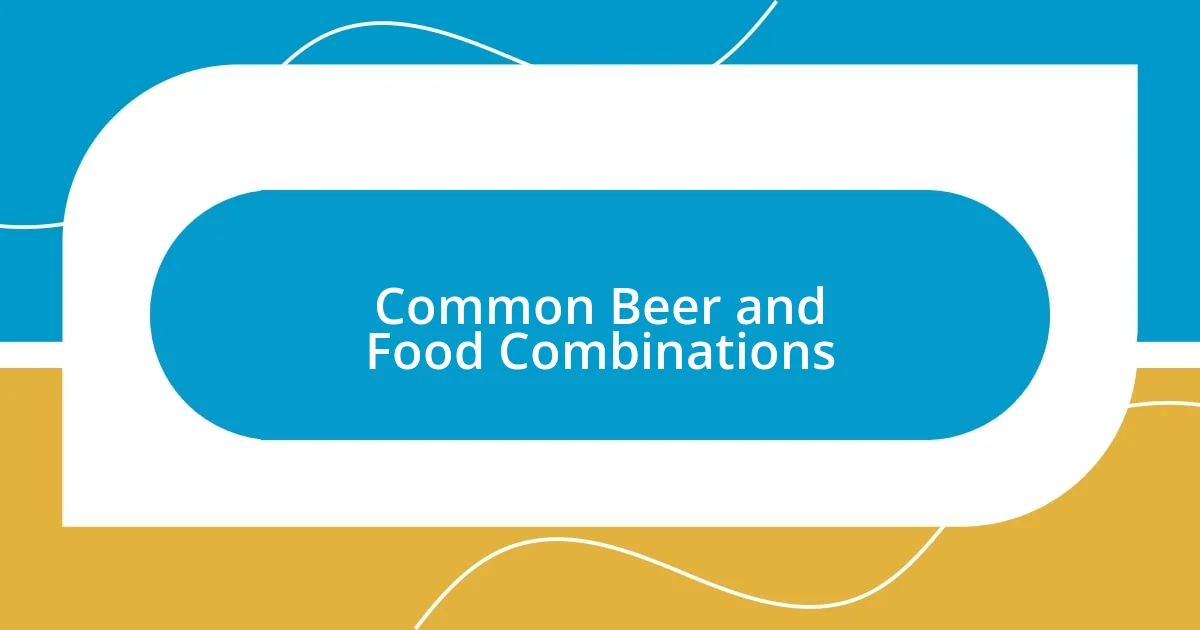Key takeaways:
- Craft beer emphasizes quality ingredients and innovative brewing techniques, allowing for unique flavor experiences that can enhance food pairings.
- Key factors in beer and food pairing include flavor intensity, carbonation level, and complementing spices to elevate the dining experience.
- Personal preferences, moods, and even visual aesthetics play a significant role in creating enjoyable and memorable beer pairings.

Understanding Craft Beer Basics
Craft beer is a fascinating world, bursting with diverse flavors and brewing techniques that reflect the passion of its creators. I still remember my first sip of a hoppy IPA; it felt like a revelation, with those unexpected notes dancing on my palate. Have you ever tried a beer that completely changed your perception of what beer could be?
At the heart of craft beer is the emphasis on quality ingredients and innovative brewing methods. Unlike mass-produced beers, craft brewers often experiment with local ingredients, which creates a unique experience in every bottle or pint. I once visited a local brewery where they used fresh lavender in their wheat beer, and the aroma was so incredible that it elevated the entire tasting journey.
Understanding the key styles of craft beer is crucial for anyone keen to explore this vibrant scene. From crisp lagers to rich stouts, each style offers something different, and pairing them with food can enhance those unique characteristics. Have you ever found joy in discovering a perfect beer and food duo? I can still recall the night a stout paired beautifully with a slice of chocolate cake, creating a harmony of flavors that was simply unforgettable.

Key Factors in Pairing Beer
When I pair beer with food, several key factors come to mind. The first is flavor intensity; matching a bold beer with equally hearty food can create a fantastic balance. I vividly recall enjoying a robust porter alongside a savory barbecue platter. The interplay of flavors was remarkable, each sip of beer enhancing the smokiness of the meat.
Another crucial factor is the beer’s carbonation level. A crisp, bubbly beer can cut through rich or creamy dishes, refreshing the palate. I remember experimenting with a citrusy pale ale while enjoying a cream-based pasta. The refreshing bite of the beer uplifted the creaminess, making each mouthful a delightful experience. It’s amazing how the right carbonation can transform a meal.
Lastly, consider the spices and ingredients in your dish. Pairing a beer that complements these elements can elevate your overall dining experience. I once paired a spicy Thai curry with a fruity Belgian ale that played off the heat perfectly. The beer not only matched the dish but also brought out layers of flavor that made me appreciate both the food and drink even more.
| Factor | Description |
|---|---|
| Flavor Intensity | Matching bold beers with hearty foods for balance. |
| Carbonation Level | Using crisp beers to refresh after rich dishes. |
| Spices and Ingredients | Complementing spices in the dish with the beer. |

Identifying Flavor Profiles in Beer
Identifying flavor profiles in beer can be a delightful adventure. I’ve found that starting with the basic categories—such as sweet, bitter, sour, and umami—helps me pinpoint what I enjoy most. For instance, when I took a deep dive into a citrusy pale ale, the vibrant hop aroma and light bitterness opened my eyes to the complexity of flavors that craft beers can offer.
To break down the flavor profiles further, here’s a handy list I’ve created, based on my experiences:
- Malty: Sweet or toasty notes often found in porters and stouts.
- Hoppy: Bitter, floral, or fruity flavors characteristic of IPAs and pale ales.
- Fruity: Bright, juicy notes from certain ales, like Belgian wits or fruited sour beers.
- Savory: Umami flavors that emerge from darker beers or those brewed with unique ingredients.
- Spicy: Common in wheat beers or Belgian styles, offering a warm kick to the palate.
I distinctly recall the first time I tasted a sour beer. The unexpected tartness surprised me, and it took a moment to wrap my head around it. However, once I embraced that unique profile, I enjoyed how the acidity complemented my meal of grilled fish. This experience ignited my curiosity about all the possible flavor combinations, showing me that identifying flavor profiles can profoundly change how we experience beer and food together.

Food Pairing Strategies for Beer
Pairing food with beer is an art, and I’ve developed a few strategies that work wonders for me. One approach I love is the contrast method. For example, think about a brewery-style IPA with its bold bitterness – it’s magical when paired with a sweet dessert like cheesecake. The bitterness cuts through the sweetness, creating a balance that’s both surprising and delightful. Have you ever experienced that moment when flavors just click? It’s one of my favorite aspects of pairing.
Another strategy I swear by is complementing flavors. I once had a session with a darker beer, a chocolate stout, while indulging in a rich chocolate brownie. The way they mirrored each other was absolutely divine; the flavors melded seamlessly, enhancing my appreciation of both. How can something so simple bring such depth to the dining experience? It’s fascinating!
Lastly, I can’t stress enough the importance of cultural pairing. Reflecting on my travels, I remember enjoying a spicy Mexican ale with fish tacos. The citrus and spice in the beer made every bite pop! Isn’t it intriguing how regional foods and beers often find their perfect match? Embracing this approach has opened my palate to a whole world of pairing possibilities.

Tips for Successful Beer Pairing
When it comes to successful beer pairing, I always remind myself to consider the intensity of both the food and the beer. For instance, I once teamed a bold stout with a heavily spiced barbecue dish. The deep flavors of the stout beautifully complemented the smoky spices, creating a rich taste experience. It’s like a satisfying dance on the palate, isn’t it?
Another tip I’ve found effective is to keep the carbonation in mind. Higher carbonation levels can really cleanse the palate, making them perfect companions for fatty or fried foods. I had a memorable evening enjoying a crispy fish fry alongside a lively lager. The crispness of the lager cut through the richness of the fried food, refreshing each bite. Have you ever noticed how that effervescent kick elevates your dining experience?
Lastly, don’t shy away from experimenting with unexpected pairings. One night, I decided to try a fruity sour beer with a spicy Asian dish. To my surprise, the tartness of the beer tamed the heat while enhancing the meal’s flavors. It was an eye-opening experience; who knew a fruity beer could harmonize so well with vibrant spices? This is what makes pairing so exciting—every combination can lead to a new discovery!

Common Beer and Food Combinations
Crispy fried foods and hoppy IPAs are a classic combo that never fails to wow me. I remember a sunny afternoon, enjoying fish and chips at a seaside pub. Each bite, crispy and golden, paired perfectly with the piney notes of an IPA. The bitterness of the hops cut through the richness of the batter, creating a delightful combination that brought me right back to the shores I love. Isn’t it incredible how certain pairings evoke such vivid memories?
For something a bit different, I’ve found that spicy foods and sweet beers are a match made in food heaven. One evening, I decided to tackle some spicy Thai curry with a fruity wheat beer. The sweetness of the beer tamed the heat while elevating the dish’s flavors. It struck me then how diverse flavors could create such balance; that moment transformed my understanding of how sweetness can soothe spice. Have you ever tasted something that completely changed your perception of a pairing?
Then there’s the charm of barbecue and smoky porters or stouts. I recall a late summer evening at a backyard barbecue where I paired a robust smoked porter with slow-cooked ribs. The deep, roasted notes of the beer mingled beautifully with the sticky, sauce-laden ribs, creating a marriage of flavors that was nothing short of revelatory. That evening stood out for me—not just for the food and drink, but for the kinship formed around shared flavors. Isn’t it amazing how food and beer can inspire connection?

Personalizing Your Beer Pairing Experience
Finding the perfect beer pairing is truly a personal journey, and I’ve come to appreciate just how much it reflects individual tastes and memories. For instance, I once enjoyed a lazy Sunday brunch where I paired a citrusy pale ale with a plate of lemon pancakes. The bright, zesty notes of the beer lifted the dish while reminding me of sun-drenched mornings spent at my grandmother’s kitchen table. It’s those kinds of moments that make pairing feel intimate and customized.
I believe in letting my mood guide my choices as well. One rainy evening, feeling a bit nostalgic, I opted for a creamy stout with a rich dessert—chocolate lava cake. The interplay between the smooth beer and the warm, gooey dessert felt like a warm hug. Have you ever thought about how your emotions influence your food and drink choices? I’ve found that tapping into my feelings at the moment can lead to the most satisfying pairings.
Ultimately, I’ve learned that there’s no one-size-fits-all approach to beer pairing. A friend once introduced me to the idea of matching flavors based on color; I tried a golden ale with roasted vegetables, and it opened my eyes to how visual aesthetics can enhance the dining experience. I still find joy in experimenting with these unconventional methods. Have you ever played around with such creative approaches? It’s this exploration of personal preferences that transforms an ordinary meal into something truly special.














